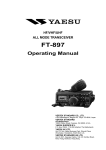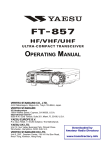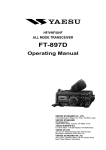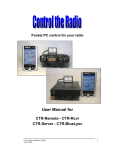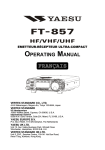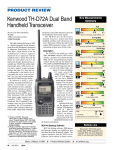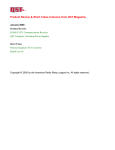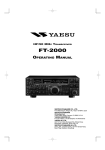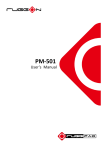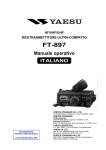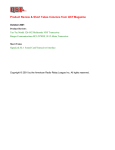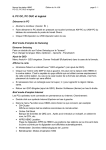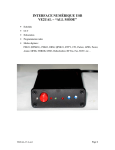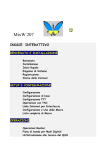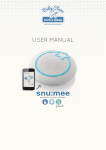Download August 2003 QST Product Reviews and Short Takes
Transcript
Product Review and Short Takes from QST Magazine August 2003 Product Reviews: Yaesu FT-857 MF/HF/VHF/UHF Transceiver ICOM IC-R5 Hand-held Receiver Short Takes: MixW Copyright © 2003 by the American Radio Relay League Inc. All rights reserved. PRODUCT REVIEW Yaesu FT-857 MF/HF/VHF/UHF Transceiver Reviewed by Rich Arland, K7SZ QST Contributing Editor When I was asked to do a review of the new Yaesu FT-857 transceiver, I thought, “What timing!” I had been looking at both the FT-857 and its bigger brother, the FT-897, for several weeks, trying to decide which one to buy. Out of the box, the first thing I had to tackle was mounting the front panel to the main portion of the radio. Thumbing through the manual I found, on page seven, exactly how to do that. The detachable front panel has become an industry standard with small, mobile transceivers. In order to remote the control head, you need to purchase the optional YSK-857 Separation Kit. It is very handy to be able to bury the main “box” of the radio under a seat or in the trunk in a mobile installation and have just the small front panel/ control head mounted on the dash. It’s a convenient, space-saving idea with the added benefit of being easily concealed when you leave the vehicle. On the surface, the newest addition to the Yaesu HF portable transceiver line looks a lot like an FT-817 on steroids. That is where the similarities end (frequency/ mode coverage and menu access not withstanding). The ’857 offers a fully adjustable output from 5 to 100 W on 1.8 through 29.7 MHz, plus 6 meters. Power out on 2 meters is 50 W and power out on 70 centimeters is 20 W. The rig can operate on voice, CW or data modes. The package is about twice the size and three times the weight of the FT-817, so while it may be suited for a mobile or base station environment, it might be a little on the heavy side for the backpacker, when combined with the added weight of a battery, antenna and accessories. Yaesu offers three filter options— the YF-122S, a 2.3 kHz SSB filter, the YF-122C 500-Hz CW filter, and the YF-122CN, a 300 Hz CW filter. The transceiver will accommodate two of these optional filters, and the installation instructions are outlined on page 120 of the manual. Filter call-up is accomplished by using the Multi Function (MF-n) menu. The FT-857 is a nice compact package, measuring 2.0×6.1×9.2 inches (HWD) and weighing 4.6 pounds. The frequency agility of this rig is amazing. The receiver covers 100 kHz to 56 MHz, 76-108 MHz, 118-164 MHz and 420- 470 MHz. The user can listen to international shortwave broadcasts, commercial AM and FM outlets, VHF aeronautical stations, public safety stations and nearly all the ham bands from 160 meters through 70 centimeters (only 222 MHz coverage is excluded). The 128 page operating manual is quite well laid out, considering the complexity of the FT-857 and the multitude of menus needed to configure the radio to your particular operating style. The manual is chock full of pertinent information. It will take you a while to assimilate the entire manual, so plan on doing a lot of reading and subsequent “playing” with the radio. The Learning Curve Getting comfortable with the controls on the FT-857 requires a bit of a learning curve, especially if you are not used to working with smaller radios utilizing layered menus. A total of 14 buttons control most of the radio’s features. The FT-857 uses multi-layered menus, accessed by the function (F) button. Since I had owned the FT-817 for over a year, the controls and menus on the FT-857 were almost intuitive. Press and release the F button and you go into the multi-function display, a series of 17 menus controlled by the three MF buttons directly below the LCD display. These are adjustments and parameters for some of the most used features of the radio. Bottom Line The FT-857 offers 100 W in a very compact package. Think of it as the FT-897 for your car. Brennan Price, N4QX Assistant Technical Editor Many of these multi-function selections are merely toggles that switch specific features on and off. These are the settings you may want to change on the fly. Examples are CW/SSB filter selection, A/B VFO selection, split frequency operation, memory storage, speech processor on/off, keyer memory playback, preamp on/off, attenuator and noise blanker on/off, and CTCSS tone encode/decode. Various display options, such as Spectrum Scope Monitor enable, LCD display size and metering assignment (Power/SWR/ ALC/S) are also selected through the multi-function keys. Press and hold the F button to enter the menu system, which controls a wide variety of the performance aspects and operating characteristics of the FT-857. This is where you configure the radio to work the way you want it to. Menu items include RF power output selection, keyer setup, CW/Phone parameters, display color and brightness, mic gain, repeater shift, keyer speed, CW pitch and the like. There are 91 menu options available. Each of these is briefly explained in a matrix, which is a lifesaver when you are trying to remember all the nuances of this tiny radio. The FT-857 is loaded with memories. The QMB (Quick Memory Bank) is used to quickly store a frequency you might want to recall in a hurry. You can load any frequency held in the QMB into one of the 200 regular memory slots at any time. While in QMB you can change frequencies, emulating the VFO mode, and you can also change the operating mode. The main memory bank is composed of 200 memory slots that can be used to store your favorite operating frequencies and [email protected] From August 2003 QST © ARRL Table 1 Yaesu FT-857, serial number 3C020019 Manufacturer’s Claimed Specifications Measured in the ARRL Lab Frequency coverage: Receive, 0.1-56, 76-108, 118-164, 420-470 MHz; transmit, 1.8-2, 3.5-4, 7-7.3, 10.1-10.15, 14-14.35, 18.068-18.168, 21-21.45, 24.89-24.99, 28-29.7, 50-54, 144-148, 430-450 MHz. Receive1 and transmit, as specified. Power requirement: Receive, 1.0 A; transmit, 22 A (100 W output). Receive, 0.6 A; transmit, 16 A. Tested at 13.8 V. Modes of operation: SSB, CW, AM, FM. As specified. Receiver Receiver Dynamic Testing SSB/CW sensitivity, bandwidth not specified, 10 dB S/N: 1.8-30 MHz, <0.2 µV; 50-54 MHz, <0.13 µV; 144-148, 430-450 MHz, <0.13 µV. Noise floor (MDS), 500 Hz filter: Preamp off 1.0 MHz –127 dBm 3.5 MHz –130 dBm 14 MHz –132 dBm 50 MHz –136 dBm 144 MHz see note 2 432 MHz see note 2 AM sensitivity, 10 dB S/N: 0.1-1.8 MHz, <32 µV; 1.8-30 MHz, <2 µV; 50-54 MHz, <1 µV; 144-148, 430-450 MHz, not specified. 10 dB (S+N)/N, 1-kHz tone, 30% modulation: Preamp off Preamp on 1.0 MHz 1.9 µV 0.91 µV 3.8 MHz 1.6 µV 0.72 µV 50 MHz 0.97 µV 0.48 µV 120 MHz see note 2 0.41 µV 144 MHz see note 2 0.42 µV 432 MHz see note 2 0.51 µV FM sensitivity, 12 dB SINAD: 28-30 MHz, <0.5 µV; 50-54, 144-148, 430-450 MHz, <0.2 µV. For 12 dB SINAD: Preamp off 29 MHz 0.51 µV 52 MHz 0.35 µV 146 MHz see note 2 440 MHz see note 2 Blocking dynamic range: Not specified. Blocking dynamic range, 500 Hz filter: Spacing 20 kHz 5 kHz Preamp off/on Preamp off/on 3.5 MHz 109/106* dB 94*/90* dB 14 MHz 109*/105* dB 94*/88 dB 50 MHz 108*/102* dB 88*/86* dB 144 MHz note 2/102* dB note 2/83* dB 432 MHz note 2/96* dB note 2/79* dB Two-tone, third-order IMD dynamic range: Not specified. Two-tone, third-order IMD dynamic range, 500 Hz filter: Spacing 20 kHz 5 kHz Preamp off/on Preamp off/on 3.5 MHz 88/88 dB 67/66 dB 14 MHz 87/86 dB 66/65 dB 50 MHz 88/85 dB 67/65 dB 144 MHz note 2/83 dB note 2/63 dB 432 MHz note 2/84 dB note 2/64 dB Third-order intercept: Not specified. Spacing 3.5 MHz 14 MHz 50 MHz 144 MHz 432 MHz Second-order intercept: Not specified. modes along with CTCSS information. The regular memory storage area is where you would also load any special net/emergency frequencies, split frequencies for DX operation as well as any nonstandard repeater splits. Any frequency stored in one of the 200 memory slots can also be tagged alphanumerically to aid in identification. From August 2003 QST © ARRL 20 kHz Preamp off/on +9.2/+1.7 dBm +4.1/–5.4 dBm +0.1/–7.1 dBm note 2/–8.8 dBm note 2/–6.9 dBm Preamp on –134 dBm –136 dBm –137 dBm –140 dBm –140 dBm –140 dBm Preamp on 0.26 µV 0.18 µV 0.19 µV 0.21 µV 5 kHz Preamp off/on –18/–25 dBm –23/–31 dBm –25/–33 dBm note 2/–37 dBm note 2/–34 dBm Preamp off, +69 dBm; preamp on, +66 dBm. The FT-857 incorporates the Smart Search feature from Yaesu’s VHF/UHF mobiles. In this mode, the rig searches above your current operating frequency and locates any active frequencies, storing them in one of the 50 Smart Search memories. These memories are considered soft memories, because any stored information will be lost if you initiate a subsequent Smart Search or go into the VFO mode. The traveling ham can make great use of this feature to locate repeaters while driving. I Can See Clearly Now The FT-857 also incorporates a Spec- FM adjacent channel rejection: Not specified. 20 kHz channel spacing, preamp on: 29 MHz, 65 dB; 52 MHz, 65 dB; 146 MHz, 65 dB; 440 MHz, 64 dB. FM two-tone, third-order IMD dynamic range: Not specified. 20 kHz channel spacing, preamp on: 29 MHz, 64 dB; 52 MHz, 63 dB; 146 MHz, 61 dB; 440 MHz, 59 dB; 10 MHz channel spacing, preamp on: 52 MHz, 88 dB; 146 MHz, 87 dB; 440 MHz, 83 dB. S-meter sensitivity: Not specified. S9 signal at 14.2 MHz: preamp off, 17 µV; preamp on, 6.6 µV; 52 MHz, preamp off, 14 µV; preamp on, 5.3 µV; 146 MHz, preamp on, 4.0 µV; 432 MHz, preamp on, 2.6 µV. Squelch sensitivity: SSB, 1.8-30 MHz, <2.5 µV; 50-54 MHz, <1 µV; 144-148, 420-450 MHz, <0.5 µV; FM, 28-30 MHz, <0.32 µV; 50-54, 144-148, 430-450 MHz, <0.16 µV. At threshold, preamp on: SSB, 14 MHz, 1.7 µV; FM, 29 MHz, 0.15 µV; 52 MHz, 0.09 µV; 146 MHz, 0.1 µV; 440 MHz, 0.11 µV. Receiver audio output: 2.5 W at 10% THD into 4 Ω. 4.0 W at 10% THD into 4 Ω. IF/audio response: Not specified. Range at –6 dB points (bandwidth): CW (500 Hz filter): 386-972 Hz (586 Hz) USB: 234-2864 Hz (2630 Hz) LSB: 286-2816 Hz (2530 Hz) AM: 140-2530 Hz (2390 Hz). IF rejection: 60 dB; image rejection, 1.8-30, 5054 MHz, 70 dB; 144-148, 430-450 MHz, 60 dB. First IF rejection, 14 MHz, 124 dB; 50 MHz, 98 dB; 144 MHz, 118 dB; 432 MHz, 129 dB; image rejection, 14 MHz, 100 dB; 50 MHz, 86 dB; 144 MHz, 99 dB; 432 MHz, 72 dB. Transmitter Transmitter Dynamic Testing Power output: HF and 50 MHz: SSB, CW, FM, 100 W, AM, 25 W (carrier); 144 MHz, SSB, CW, FM, 50 W, AM, 12.5 W (carrier); 430 MHz, SSB, CW, FM, 20 W, AM, 5 W (carrier). HF and 50 MHz: CW, SSB, FM, typically 102 W high, 3 W low; AM, typically 20 W high, 1 W low; 144 MHz: CW, SSB, FM, typically 51 W high, 3.5 W low; AM, typically 12 W high, 1.5 W low; 430 MHz: CW, SSB, FM, typically 19 W high, 2 W low; AM, typically 5 W high, 1 W low. Spurious-signal and harmonic suppression: ≥50 dB on HF; ≥60 dB on VHF and UHF. HF, 53 dB; 50 MHz, 61 dB; 144 MHz, 62 dB; 430 MHz, 63 dB. Meets FCC requirements for spectral purity. SSB carrier suppression: >40 dB. 53 dB. Undesired sideband suppression: >50 dB. 56 dB. Third-order intermodulation distortion (IMD) products: Not specified. See Figures 1 and 2. CW keyer speed range: Not specified. 4 to 59 WPM. CW keying characteristics: Not specified. See Figure 3. Transmit-receive turn-around time (PTT release to 50% audio output): Not specified. S9 signal, 12 ms. Receive-transmit turnaround time (tx delay): Not specified. SSB, 21 ms; FM, 15 ms. Unit is suitable for use on AMTOR. Composite transmitted noise: Not specified. See Figures 4 and 5. Bit-error rate (BER), 9600-baud: Not specified. 146 MHz: Receiver: BER at 12 dB SINAD, 2.8×10–3; BER at 16 dB SINAD, 1.4×10–4; BER at –50 dBm, <1.0×10–5; transmitter: BER at 12 dB SINAD, 7.7×10–4; BER at 12 dB SINAD + 30 dB, <1.0×10–5. 440 MHz: Receiver: BER at 12-dB SINAD, 3.3×10–3; BER at 16 dB SINAD, 1.5×10–4; BER at –50 dBm, <1.0×10–5; transmitter: BER at 12 dB SINAD, 8.3×10–4; BER at 12 dB SINAD + 30 dB, <1.0×10–5. Size (height, width, depth): 2.0×6.1×9.2 inches; weight, 4.6 pounds. Note: Unless otherwise noted, all dynamic range measurements are taken at the ARRL Lab standard spacing of 20 kHz. *Measurement was noise-limited at the value indicated. 1 Receive sensitivity is reduced below 350 kHz. 2 IPO not available above 56 MHz. trum Scope Monitor that actually allows you to “see” activity above and below your operating frequency, much like a spectrum analyzer. This feature is active in the VFO and memory modes. When activated, the Spectrum Scope Monitor displays relative signal strength (on the LCD) on frequencies immediately adja- cent to your operating frequency in various frequency increments that are selected based upon the mode in use. This feature is nice for keeping track of action during contests and to pinpoint activity on a given band. Several scanning options are available on the FT-857. In the VFO mode the trans- ceiver will scan either above or below the VFO frequency (whichever you select), stopping on active frequencies. In the memory mode, the transceiver will scan through the memory channels and halt on an active frequency. In addition, you can program the rig to skip selected memory channels. In the Programmable Memory From August 2003 QST © ARRL 0 –60 Reference Level: 0 dB PEP –10 –70 –20 Reference Level: - 60 dBc/Hz Vertical Scale: dBc/Hz –80 –30 –90 –40 –100 –50 –110 –60 –120 –70 –130 –80 –10 –8 –6 –4 –2 0 2 4 Frequency Offset (kHz) 6 8 –140 2 10 Figure 1—Worst-case spectral display of the FT-857 transmitter during two-tone intermodulation distortion (IMD) testing on MF and HF. The worst-case third-order product is approximately 25 dB below PEP output, and the worst-case fifthorder product is down approximately 40 dB. The transmitter was being operated at 100 W PEP output at 1.85 MHz. Figure 3—Worst-case CW keying waveform for the FT-857 showing the first two dits using external keying. Equivalent keying speed is approximately 60 wpm. The upper trace is the actual key closure; the lower trace is the RF envelope. Horizontal divisions are 10 ms. The transmitter was being operated at 100 W output at 14.2 MHz. –60 0 Reference Level: 0 dB PEP –10 –70 –20 –80 –30 –90 –40 –100 –50 –110 –60 –120 –70 –130 –80 –10 –8 –6 –4 –2 0 2 4 Frequency Offset (kHz) 6 8 10 –140 2 Reference Level: - 60 dBc/Hz Vertical Scale: dBc/Hz 4 6 8 10 12 14 16 18 20 Frequency Sweep: 2 to 22 kHz from Carrier 22 Figure 2—Worst-case spectral display of the FT-857 transmitter during two-tone intermodulation distortion (IMD) testing on VHF and UHF. The worst-case third-order product is approximately 25 dB below PEP output, and the worst-case fifth-order product is down approximately 35 dB. The transmitter was being operated at 100 W PEP output at 50.2 MHz. Figure 4—Worst-case spectral display of the FT-857 transmitter output during composite-noise testing on MF and HF. Power output is 100 W at 14.02 MHz. The carrier, off the left edge of the plot, is not shown. This plot shows composite transmitted noise 2 to 22 kHz from the carrier. Scan mode the transceiver will scan between user prescribed limits. Finally, the FT-857 has a “Priority Channel” scan mode whereby the priority channel (memory channel M-001) is periodically checked with the transceiver in the VFO or Memory mode. Once activity on M-001 is detected, the transceiver will pause on the priority channel. This optional cable performs level conversion for proper serial port to radio operation. Yaesu does not produce any CAT software, but there are several sources on the Internet. The CAT’s Out of the Bag Yaesu’s CAT System provides a method of controlling various aspects of the FT-857 via your computer. By using third-party software packages like contest logging software, your computer can communicate with the FT-857 without any redundant operator intervention, making contesting a real pleasure. In order to use the CAT System, you’ll need the optional CT-62 cable, which interfaces your computer’s RS-232 port to the CAT/Linear jack on the rear apron of the FT-857. From August 2003 QST © ARRL On-Air Operations Reading the manual, perusing the specifications and dissecting the Lab test results is fine, but this only tells part of the story. You can have a rig with outstanding specs, but if you are not comfortable using it, you’re not going to be satisfied and you are not going to have any fun with the radio. Thankfully, the FT-857 is a dream rig to use. One operational feature I really like is the ability to set the LCD screen color to change when you change bands, band segments and/or modes. This means you can select different colors for FM, SSB, DATA and AM, or color-code band segments like QRP calling frequencies, 4 6 8 10 12 14 16 18 20 Frequency Sweep: 2 to 22 kHz from Carrier 22 Figure 5—Worst-case spectral display of the FT-857 transmitter output during composite-noise testing on VHF and UHF. Power output is 20 W at 432.02 MHz. The carrier, off the left edge of the plot, is not shown. This plot shows composite transmitted noise 2 to 22 kHz from the carrier. DX watering holes, and simplex or repeater sub-bands, making it a lot easier to navigate through the memory maze. On-air testing with the FT-857 provided me with many hours of fun on the QRP bands, and some serious DXing, using higher power, on the low end of 20 meters. Our local ARES group is quite active, offering three weekly nets on two local repeaters. I used the ’857 to check into several of these nets and to work some folks via local 2-meter and 70-centimeter repeaters. I received great audio reports on both SSB and FM using the factory default settings. CW operation provided a couple of twists. The FT-857 does not feature full break-in (QSK) keying, or anything really close to it. The T/R switchover is adjustable from 3000 ms down to 30 ms, but even at that, the CW keying is not full break-in. In addition, the T/R relay (yes, the FT-857 uses a relay to switch between transmit and receive) chatters like mad at speed. So I adjusted the T/R changeover to around 300 ms, which delays the transmitter between characters at 15 WPM and higher. This seems to provide the best trade-off between a chattering relay and receiver recovery time. One very nice feature is the TX/BUSY indicator, just to the left of the main tuning knob. This indicator glows green when the squelch is open, red during transmit and bright blue when the incoming signal is zero-beat with the IF passband in the CW mode (with the IF shift off). This makes easy work of getting exactly on the transmitting station’s frequency. This is great for those of us who lack perfect pitch. In addition, when the radio is in the FM mode, this indicator will glow blue when you are receiving a signal with a CTCSS/DCS encoded tone that matches the one to which your trans- ceiver is set. Nice touch! The ability to load up to three “canned” messages for instant reply via a single press of one of the three Multi-Function buttons (Ply1, Ply2, Ply3 in multi-function menu MFo) is a great feature. You can thus configure the keyer as a contest keyer (although it won’t handle serial numbers), reducing the number of boxes you have to drag along when operating portable or mobile. CW DXing using the IF shift and Clarifier (RIT) controls on the FT-857 proved to be quite pleasant. The combination of these two features and the 500-Hz Collins mechanical filter enabled me to snag a couple of new countries in the middle of large pileups. Split operation is a breeze using the dual VFOs on the FT-857. The DX can run but they can’t hide! Receiver performance is similar to but slightly degraded from Yaesu’s FT-897 model, reviewed in the May 2003 issue of QST. As a rule, dynamic range (blocking and third order IMD) were slightly worse. However, the third-order and second-order intercept points improved slightly from the ’857’s bulkier older brother. See Table 1 for the complete test results. Quirks and Annoyances No rig is perfect, and the FT-857 is no exception. Here are a few thoughts on how Yaesu could improve the package. A set of laminated plastic cards listing the 91 different menu system items and the 17 different multi-function options would be useful as a field guide. Having a set of small, readily available cheat sheets would make life a whole lot easier on the user and save valuable space and weight by not having to carry the entire manual around. Then there is the dc power cord, which ought to be redesigned. Many manufacturers use no. 10 or 12 AWG red/black “zip cord” for dc power cabling. Yaesu decided to use separate red/black wires with a plug on one end and in-line fuse holders on the other. Unless you remove the fuse holders or lop off the plug that mates to the radio, there is no practical way to run this power cord inside a vehicle. Yaesu should use “zip cord” and provide the fuse holders for the user to install after the power cabling has been run in the vehicle. Affordable and Portable Would I buy this radio? In a heartbeat! The FT-857 is a very capable rig designed with the mobile/portable ham radio operator in mind. The folks at Yaesu have done their homework and given us a rig that offers outstanding performance with 100 W of RF in a very small package. Yaesu designers have taken up the challenge to improve on their tremendously successful FT-817 and the result is the FT857. Well done, Yaesu! Manufacturer: Vertex Standard USA, 10900 Walker St, Cypress, CA 90630; tel 714-827-7600; www.vxstdusa.com. Price: $849.95. ICOM IC-R5 Hand-held Receiver Reviewed by Brennan Price, N4QX Assistant Technical Editor The past few years have seen the introduction of a number of handheld receivers. Some have more features than others, and buyers have a wide range of options to choose from. A few of the more sophisticated models even have the ability to receive the most popular Amateur Radio HF operating modes, single sideband and CW. Some amateurs findcarrying a comprehensive handheld receiver useful. While many transceivers have multiple watch functions and multiple VFOs, sometimes they are poor substitutes for a completely separate receiver. As a result, a number of amateur manufacturers have added hand-held receivers to their lines. ICOM’s latest offering is the IC-R5. About the size of its latest multiband hand-held receiver, the IC-T90A, the ’R5 is not among the CW and single-sideband capable models. Nevertheless, at its size and price, it is an impressive machine, scanning and sounding AM, narrowband FM and broadcast FM signals with speed and ease. From the AM broadcast band, through the shortwaves, and into the VHF and UHF amateur, aviation, and public service bands, the IC-R5 offers comprehensive coverage from 150 kHz to 1300 MHz, cellular frequencies excluded. The first impression of the radio is, “It’s all speaker.” Merely seven front panel keys—all on top of the speaker and below the LCD and the 10-character LCD readout, two side panel keys, and a DIAL constitute the user’s interface with the radio. The user’s manual does a credible job explaining their function, however, and I found the limited controls easy to use. All tuning is done through the DIAL, with each click executing a band-specific tuning step. Large steps of 1 MHz are accomplished by holding the F side button while clicking the DIAL . The ’R5 comes with two Ni-Cd size AA batteries and a plug-in wall charger. The initial charging routine is a little tricky, and not nearly as intuitive as loading the batteries and plugging in the charger. A quick read of the manual is advisable. The BAND key toggles between 12 different frequency bands, each with a Bottom Line ICOM’s IC-R5 is tiny, inexpensive and simple, and it’s a nice station accessory for amateurs looking for these qualities. distinct and adjustable tuning step. The DIAL controls frequency selection, while the and keys control volume level from the 0.1-W speaker. A thousand standard memory channels are available and may be assigned to any of 18 memory banks. Twenty-five pairs of band edge memories can delineate frequently scanned band segments, such as the 145.1-145.5 MHz 2-meter repeater segment. Both manual tuning and scanning can be performed in VFO and memory modes. United States television audio frequencies and weather frequencies are preprogrammed and have special displays. Both the input and the output of an Amateur Radio repeater (or any other repeater) can be monitored through the receiver’s duplex operation feature. Briefly, this is accomplished by setting the offset, enabling duplex mode, and pressing the SQL button to monitor the repeater input directly. The actual procedure for setting the offset and turning the duplex mode on is somewhat convoluted; there are eight steps of button pushing and DIAL turning between the setting of the output frequency and when the input frequency can be monitored at the touch of a button. Also of interest to amateurs is the ’R5’s ability to detect and decode CTCSS tones and DCS codes. Particularly useful is the manual’s frequency table, which lists the audio frequencies for television channels in the United From August 2003 QST © ARRL Table 2 ICOM IC-R5, serial number 0601263 Manufacturer’s Claimed Specifications Measured in the ARRL Lab Frequency coverage: Receive, 0.15-822; 851-867; 896-1310 MHz. Receive, as specified.1 Modes of operation: FM, WFM, AM. As specified. Power requirements: 0.17 A (max audio), 6 V dc. 0.15 A (max volume, no signal), tested at 6.0 V dc. Size (HWD): 3.4×2.3×1.1 inches; weight, 6.5 ounces. AM sensitivity (10 dB S/N): 0.5-5 MHz, 1.3 µV; 5-30 MHz, 0.71 µV; 118-136 MHz, 222-247 MHz, 0.56 µV; 247-330 MHz, 0.71 µV. AM, test signal modulated 30% with a 1-kHz tone, 10 dB (S+N)/N: 1.0 MHz, 1.1 µV; 3.8 MHz, 0.58 µV; 53 MHz, 0.4 µV; 120 MHz, 0.46 µV; 146 MHz, 0.41 µV; 440 MHz, 0.6 µV; FM narrow sensitivity (12 dB SINAD): 1.6-5 MHz, 0.32 µV; 5-118 MHz, 0.2 µV; 118-247 MHz, 0.18 µV; 247-330 MHz, 0.2 µV; 330-470 MHz, 0.18 µV; 470-1000 MHz, 0.28 µV; 10001310 MHz, 0.35 µV. FM narrow, 12 dB SINAD: 29 MHz, 0.17 µV; 52 MHz, 0.14 µV; 146 MHz, 0.15 µV; 222 MHz, 0.14 µV; 440 MHz, 0.2 µV; 906 MHz, 0.23 µV; 1270 MHz, 0.28 µV. FM wide sensitivity (12 dB SINAD): 76-108 MHz, 0.89 µV; 175-222 MHz, 0.71 µV; 470-770 MHz, 1.0 µV. FM wide, 12 dB SINAD: 100 MHz, 0.84 µV. FM adjacent channel rejection: Not specified. 20 kHz channel spacing: 29 MHz, 56 dB; 52 MHz, 57 dB; 146 MHz, 51 dB; 222 MHz, 49 dB; 440 MHz, 53 dB; 906 MHz, 57 dB; 1270 MHz, 49 dB. FM two-tone, third-order IMD dynamic range: Not specified. 20 kHz channel spacing: 29 MHz, 48 dB; 52 MHz, 49 dB; 146 MHz, 47 dB; 222 MHz, 50 dB; 440 MHz, 47 dB; 906 MHz, 55 dB; 1270 MHz, 49 dB.* 10 MHz channel spacing: 52 MHz, 57 dB; 146 MHz, 69 dB; 440 MHz, 59 dB. Squelch sensitivity (threshold): Not specified. At threshold: FM, 29 MHz, 0.34 µV; 52 MHz, 0.38 µV; 146 MHz, 0.34 µV; 222 MHz, 0.38 µV; 440 MHz, 0.38 µV; 906 MHz, 0.8 µV; 1270 MHz, 1.1 µV. Audio output: 0.1 W at 10% THD into 8 Ω. 0.125 W at 8% THD into 8 Ω2 IF/audio response: Not specified. Range at –6 dB points (bandwidth): AM: 306-3562 Hz (3256 Hz). Spurious and Image rejection: Not specified. IF: 29 MHz, 75 dB; 52 MHz, 31 dB; 144 MHz, 71 dB; 222 MHz, 21 dB; 440 MHz, 53 dB; 906 MHz, 61 dB; 1270 MHz, 59 dB; Image: 29 MHz, 56 dB; 52 MHz, 53 dB; 146 MHz, 99 dB; 222 MHz, 43 dB, 440 MHz, 74 dB; 906 MHz, 33 dB; 1270 MHz, 9 dB. Except as noted, all dynamic range measurements were taken using the ARRL Lab standard spacing of 20 kHz. *Measurement was noise-limited at the value indicated. 1Sensitivity degrades slightly below 500 kHz. 2Volume control is stepped—the next higher step produced 14% THD. States and other parts of the world. The 68 United States channels are programmed into a special band at the factory, but the table is a terrific ready-reference for travel abroad. The table also includes widely used frequencies in the Aviation, General Mobile, Family Radio, and Business Radio Services. Programming and scanning is quite easy. In fact, the two can be combined through an automatic memory write function, which can store up to 200 active frequencies automatically as a band is scanned. This is useful when you visit a place without a frequency list or repeater directory handy. Programming a frequency into a standard memory channel is as simple as tuning the frequency in the VFO, pressing the S.MW button for one second, selecting the memory channel number, and pressing the From August 2003 QST © ARRL S.MW button again. The receiver makes efficient use of the limited controls it has. Listening to the ’R5 is pleasant. The prominent speaker cranks out 0.125 W at 8% THD into 8 Ω, according to ARRL Lab test results. The sensitivity measurements meet and in some cases exceed what one would expect from a handheld receiver in this price class, and the dynamic range measurements are about as expected. All VHF and UHF stations that I expected to hear from my location were indeed heard by the ’R5, and I was pleasantly surprised with its HF performance. See Table 2 for the ARRL Lab’s measurements. The ’R5 comes with a SMA-threaded rubber duck antenna. Of course, such an antenna is ideal for use at higher VHF and UHF frequencies. Only the strongest meduimwave and shortwave stations can be adequately detected by this antenna, but shortwave listeners know that a substantial external antenna is imperative for receivers—even hand-helds. Nevertheless, I received Hartford-area AM broadcasters and even transmissions from Radio Canada International’s Sackville, New Brunswick, facility with no difficulty. The IC-R5 is a solid offering, easily receiving strong broadcast signals and rapidly scanning standard or user-designated band segments. Its portability and price are attractive, and hams unwilling or not needing to spend the money for additional modes may find the ’R5 a useful accessory. Manufacturer: ICOM America, 2380 116th Ave NE, Bellevue, WA 98004; tel 425-454-8155; fax 425-4541509; www.icomamerica.com. Price: $199.95. SHORT TAKES MixW Is it possible to discuss a multifaceted piece of software in a single QST page? MixW Windows is essentially one-stop shopping for Amateur Radio digital operating. It’s difficult to do justice to the “Swiss Army Knife” of digital software in less than 800 words. What Can’t It Do? Assuming you own a sound-card-equipped Windows PC and an appropriate sound-card interface, MixW gives you the ability to send and receive RTTY, CW, PSK31, Hellschreiber, MFSK16, FSK31, PSK63, Throb, MT63, SSTV, packet (HF and VHF) and AMTOR. You can also receive PACTOR-I and fax with MixW. MixW will “talk” to your transceiver if it is CAT compatible, which many are these days. This means you can manipulate your rig from within MixW. With software such as PCAnywhere, you can even do this remotely. MixW can also interface with your antenna rotator. MixW incorporates a sophisticated logging program that includes a “contest mode” with configurations for a number of popular digital contests. When you click on a call sign in the receive window, MixW enters the call into the log and displays the country information according to the prefix. MixW will export to ADIF and Cabrillo formats. And, yes, it prints QSLs and QSL labels. As they say in the TV commercials, “Wait! There’s more!” MixW will function as a “voice keyer” for contest operating. It can grab spots from your local DXcluster via packet radio or the Internet. MixW will even monitor and decode the NCDXF/ IARU CW propagation beacons (your PC needs to have a very accurate clock for this function to work properly). On the Air with MixW After two months, I am still exploring the features of MixW, but what I’ve seen so far is impressive. With the selectable waterfall, spectrum and tuning displays, MixW is quite easy to op- Figure 1—PAØWCH sends a picture of himself while making an MFSK16 contact with PY7MG. Steve Ford, WB8IMY From August 2003 QST © ARRL erate, regardless of mode. Even digital modes as notoriously difficult to tune as HF packet and MFSK16 yielded quickly to MixW. Speaking of MFSK16, one of the new aspects of this mode is the ability to send images at any time during a QSO. The practice is controversial among US amateurs because, depending on how you interpret Part 97, transmissions with image content may be illegal within the so-called CW/digital subbands (which is why traditional analog SSTV QSOs are conducted in the phone portions of the bands). I have already seen a number of these image-added MFSK16 QSOs taking place. MixW automates the process in a clever way. If you are copying text and the operator suddenly begins sending an image, MixW automatically opens a tiny window, displays the picture (see Figure 1) and then returns to the text mode. PSK31 operation with MixW was a joy. You can “bookmark” stations in the tuning display and even scan for signals throughout the passband. The tuning indicator analyzes signal characteristics and provides RST reports on the fly (a handy feature). MixW did a fine job copying RTTY. Its performance might fall a little short of the highly praised MMTTY software, but it is close. Visual modes such as SSTV and Hellschreiber worked very well. Hellschreiber was particularly fun with MixW. See Figure 2. As with all amateur software, I found that performance in the CW mode is most reliable with perfect fists and strong signals. Conclusion To experience MixW with minimal investment, download and test-drive the fully functional 15-day version. You can download it from Jim Jaffe, WA2VOS, at www.nvbb.net/~jaffejim/ MixWpage.htm, or from the MixW site at www.mixw.net. The registered version will set you back $50, which is not bad at all for such a highly capable application. System requirements: Pentium 166 or faster PC running Windows 98, ME, NT, 2000 or XP with a 16-bit SoundBlastercompatible sound card. Figure 2—WA9HCZ and K5WTA enjoying a Hellschreiber QSO. QST Editor [email protected]








